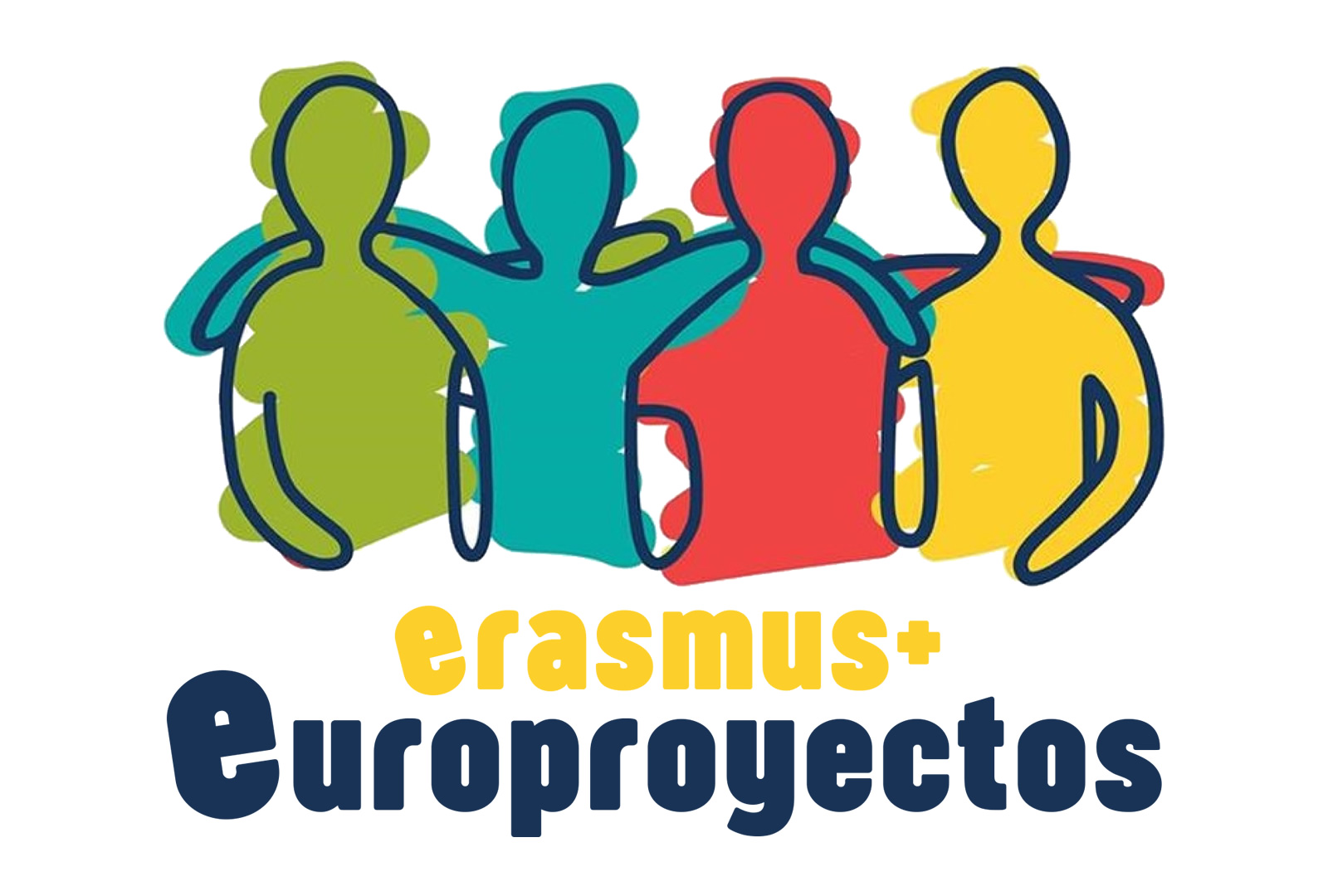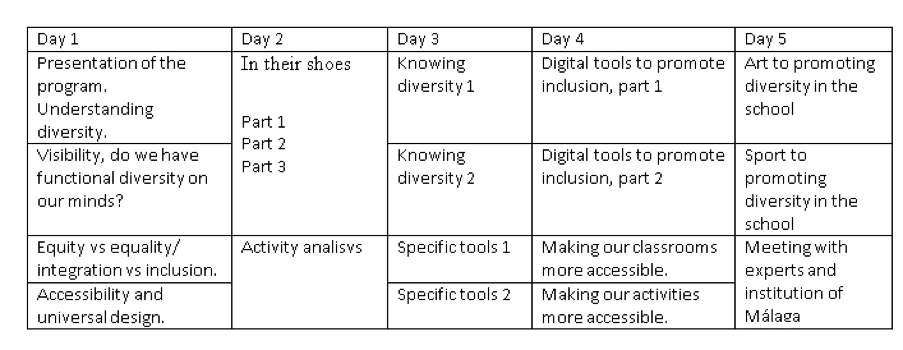
04 Feb Course inclusion
COURSE DESCRIPTION.
One of the objective of EU during the period of 2012 -2020 and now 2021 – 2027, focused into the collective of people with functional diversity, it is to empower them to participate and enjoy their life fully and to purpose solutions about increasing the conscience of different sector of the society in the needs of this collective when speaking about barriers, social and physical barriers.
EU said to us, promoting entities of their values and objectives, that we need to create spaces more accessible, promoting equity and equality, facilitating in this way the participation of the people with functional diversity in the social life.
To achieve those objectives, and to promote the accessibility and inclusion of people with functional diversity into the society, we need to put the focus on the first institution that these people will use in their life, which are the educational centres. It’s essential to create accessible and inclusive schools and high schools in order to create spaces where people with functional diversity will be able to develop themselves and also to increase the conscience of all the students about the importance of creating more accessible institutions and society. From education we start building our societies, so it is a great idea to promote these values, concepts and action from those entities.
And these needs are what we are going to approach since this training course, organized by the union of professionals of the education with professionals of the inclusion of people with functional diversity.
Learning outcomes of the course:
With this course we will train the teachers in order to allow them to create inclusive spaces and activities inside the learning rooms and other spaces in the schools and high schools. Our idea is to bring tools and competences to the teachers that will make them able to face the situations that people with functional diversity will suffer when studying in their institution, promoting in this way their inclusion and the values of the other students.
Trainees will be instructed in key concepts as inclusion and integration, universal design, activity analysis, understanding the situations faced for the students with functional diversity, empathy and cooperation of all the students and institution to achieve this objective, different tools to achieve, the paper of new technologies into the inclusion inside the learning rooms of schools and what tools we can use to promote inclusion and accessibility in the daily life of our educational centres.
Schedule of the training course:

Presentation of the program. Understanding diversity.
Visibility, do we have functional diversity in our minds?
In order to promote teamwork and start going deeper in the topic with the group. For that we will make a reflection workshop using the city of Málaga. We will go out and observe different aspects:
- How many people with functional diversity did we watch during the walk into the city? Were they alone or they were receiving some support?
- Check out at least 15 different businesses … ¿Did you notice any worker with functional diversity working there?
- And buying?
- Can you see people with functional diversity in the posters and marketing initiatives of brands into the city?
- Try to talk with at least three people about their perception about accessibility in Málaga city.
- Make at least three photos in good practices in the inclusion of people with functional diversity.
- Male at least three pictures of bad practices in the inclusion of people with functional diversity.
- Try to discover, by asking the people of Málaga, if they know any local collective or entities (group of people, NGOs, social services …) which are working for the inclusion of people with functional diversity.
- Check out at least the accessibility of at least 5 WC.
- How many people can you see doing sport? How many of them are people with functional diversity?
- How many kids do you see playing? Could you see kids with functional diversity among them?
- Can you make a reflection comparing Málaga with your city? Do you find the same problems? There are things you could include in your community? Could we include something we don’t have than you have?
- Last question to make the reflection. As teachers, were we aware of all those things? When we want to make and promote inclusion at the school, we understand that the final goal is to give tools and competences to young people with functional diversity to be able to face reality?
Equity vs equality / integration vs inclusion.
In this workshop we will work about some key terms we need to understand in order to plan actions to impact and facilitate the learning processes of students with functional diversity.
– Equality vs equity.
We will explain with examples what means activities and tasks for all (equality), but not having the same opportunities to realize them successfully. With this we will discuss how countries can make possible equality but to promote equity we need individual actions attending specific circumstances. Also we will speak about the concept intersectionality, point in that situations converge and we need to analize and impact if we want to achive equity.
– Integration vs inclusion
We will discuss facing aspects of both concepts, like:
In the education works:
- Classroom: Total and unconditioned insertion.
- Students: Partial and conditioned insertion.
In the social live and philosophy:
- Accept the needs because they are real, and with them we search the correct solution.
- Try to hide diversity and differences.
Need:
- Big changes in the system.
- Little changes in the environment we have.
It’s focused:
- On competences.
- Syndrome, diagnosed, sickness.
Based on:
- Cooperation, equity and solidarity.
- Equality and competition.
Philosophy
- Accept the differences of the people and get advantages from them.
- Try to change and correct the differences.
Search:
- Elimination of social barriers.
- To adapt people with functional diversity to the group.
In education, having the same rights mean:
- People have what they need, individually.
- All students will have the same.
Educative style
- General education.
- Special education.
Values:
- Accept the diversity of people respecting individual characteristics.
- Push people with functional diversity as much as possible to social standards, their way of thinning and being.
We will discuss these aspects one by one, facing them and deciding what is integration and what is inclusion.
Accessibility and universal design.
In this workshop we will work about two other key concepts speaking about inclusion of people with functional diversity. For that we will work with material of O.N.C.E, totally experts in these concepts.
In their shoes
Main activities of the course, in which the teachers will increase their understanding about the barriers the students with functional diversity will face. They will experiment with physical, psychological and social barriers.
Barriers related with symptoms and disability.
During this activity, we will simulate 5 types of disabilities that teachers will have to face, and understand what means to realize some activities with limited capacities.
We will make tasks to overcome simulating:
- Amputation.
- Blindness.
- Speaking problems.
- Reduced mobility.
- Mental illness.
Psychological barriers – labels.
We will stick some labels to each participant and we will indicate to our teachers to interact among them regarding the labels. The labels will be things like “I need help”, “I am joking all the time”, “you like me”, I spit when I talk”, etc.
Social barriers – dependency.
We will play the video “Quiero seguir opinando” with English subtitles and after that participants will have to sole the next questions:
– How do you think she felt?
– What were they doing wrong?
– What would you do in this position?
– Do you think this behaviour is usual with our student with functional diversity?
– Did we do that in the past with students and/or other people?
Análisis de la Actividad
We will use a board game and we will give the tool of activity analysis and other support documents.
– Activity analysis sample
– Activity demands
– Performance skills glossary
We will explain to participants that activity analysis is a tool of occupational therapy but we think, with a modification, can be used by teachers in order to improve the accessibility and inclusion of the school, since we are going to understand better the needs of the person.
First we will see the glossary. One teacher will observe how the others play this board game, writing down the abilities being used in the document “activity demands”. After that, we will fulfil the document Activity analysis.
In this way, the teachers will understand how to divide activity in tasks, like in components, in order to analyse what components avoid the participation of some groups and impact in these tasks (change them, modify them, support them …)
Let’s Adapt
Now that participants know the tools provided, we will adapt some activity they realize in the school, like an excursion, art lesson, physical education lesson,… and we will provide an example of disability, an easy one.
We will support this process to our teachers and also, after doing this analysis with real tasks in schools we will give real examples and propositions which are working nowadays.
Knowing diversity 1 and 2
In these activities we will understand in a deeper and more professional way the characteristics of two collectives of students with functional diversity. The group will choose two disabilities/conditions for these sessions. We will promote them to choose the most common ones in their schools.
Specific tools 1 and 2
Attending the previous workshops we will provide specific tools and measures specials and focus for the conditions we were discussing in the morning. We will provide at least 4 different tools to improve their learning process in the school.
Digital tools to promote inclusion
Technology and ICTs are tools that we need to include in our daily life’s, and of course we can find a lot of different tools (devices, software’s, app for phones, etc.). Again, attending to the collectives the teachers will want to work in this course, we will teach the best digitals tool to approach the conditions and possible problems teachers will find when facing this kind of students.
Making our classrooms more accessible.
Using the concepts we learnt during this week. We will work directly with the examples of
Making our activities more accessible.
Art to promoting diversity in the school
Sport to promoting diversity in the school
Meeting with experts and institution of Málaga

Sorry, the comment form is closed at this time.